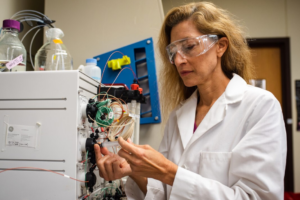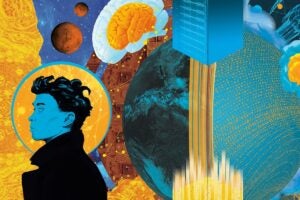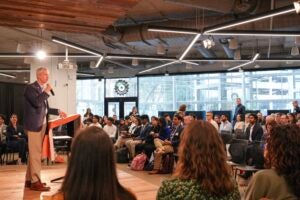
Stephanie Piefer Niemeyer, The Blanton’s manager of docent and university programs, writes about an unusual partnership that exposes medical students to the arts in a way that enhances their education in both fields.
“OK, what was the first thing you noticed when you looked at this painting?” I asked a group visiting the Blanton Museum of Art at The University of Texas at Austin recently.
“It looks like her breasts are in a plate,” was the first response.
This is how most of my conversations begin with people touring the galleries. I do not always start with something as startling as the 17th-century painting of the martyred St. Agatha by Lorenzo Lippi, but with these University of Texas Medical Branch (UTMB) students, this museum tour and discussion get us off to a good start.

Traditionally, St. Agatha is revered as the patron of nurses, and in recent years, breast cancer survivors have venerated her because of her life and subsequent torture at the hands of her fiancé. For her feast day in Sicily, little cakes are baked in her honor, oftentimes in the shape of breasts.
The medical students and I will start with the first comment. “What are her breasts doing in a plate?” We follow that up with a look at her face. “What does her expression say to you?” We then look at her body. “How would you describe her posture?” Afterward, we move out farther and consider the whole scene. “What is the mood of this painting?” Rousing discussion ensues.
Wait a second. What are medical students doing in an art museum? Shouldn’t they be dissecting something? Well, they are.
They are dissecting art.
Across the country medical school residents, nursing students, physical therapists, New York City police yes, cops are visiting art museums to sharpen their observation skills. The Blanton and UTMB’s Internal Medicine residency program at Seton Healthcare Family have been working together to bring small groups of third-year medical students to look, consider, think, speculate, construe and conclude what could be going on in some of our most beloved works of art.
For me, this was re-visiting a program I worked on at the Museum of Fine Arts, Houston that was based on The Frick Collection’s “Art of Observation” collaboration with Yale University Medical School. When two enthusiastic chief residents, Drs. Holli Sadler and Murad Aslam, approached The Blanton with a similar idea, I was thrilled to get started.
Together, the three of us designed this pilot program at The Blanton that is approaching its one-year anniversary.
“Much of what we do in medicine is searching for the correct diagnoses, sometimes overlooking how other aspects of the patient’s life affect their medical issues,” said Sadler, an Internal Medicine chief resident at Seton. “The time spent in the galleries reminds the medical students to appreciate the entirety of the patient, not just their diagnoses which, in the end, allows them to provide better patient-centered care.”
In addition to looking upstairs in The Blanton’s rich permanent collection of paintings and sculptures, we’ve added a stop in the Wilkinson Print Study Center, located on the first floor of The Blanton’s Michener Building. The center houses 15,000 works on paper that museum visitors can view by appointment.
The Ware Collection of Medical Prints in The Blanton’s permanent collection provides a number of historical and contemporary prints related to the study of medicine that supports the students’ understanding of the history of their future profession and hones their examination skills by having them look closely at the intricacies of prints.
The idea is that by becoming thoughtful, careful observers, these future doctors will become more comfortable observing a patient’s unspoken visual cues that may alert them to a diagnosis or a secondary condition. Perfecting their study of visual cues, whether by diagnosing a painting or a person, will make them more attentive to their patients.



